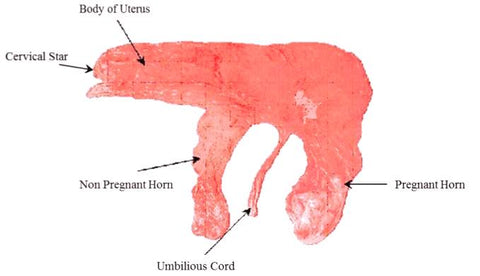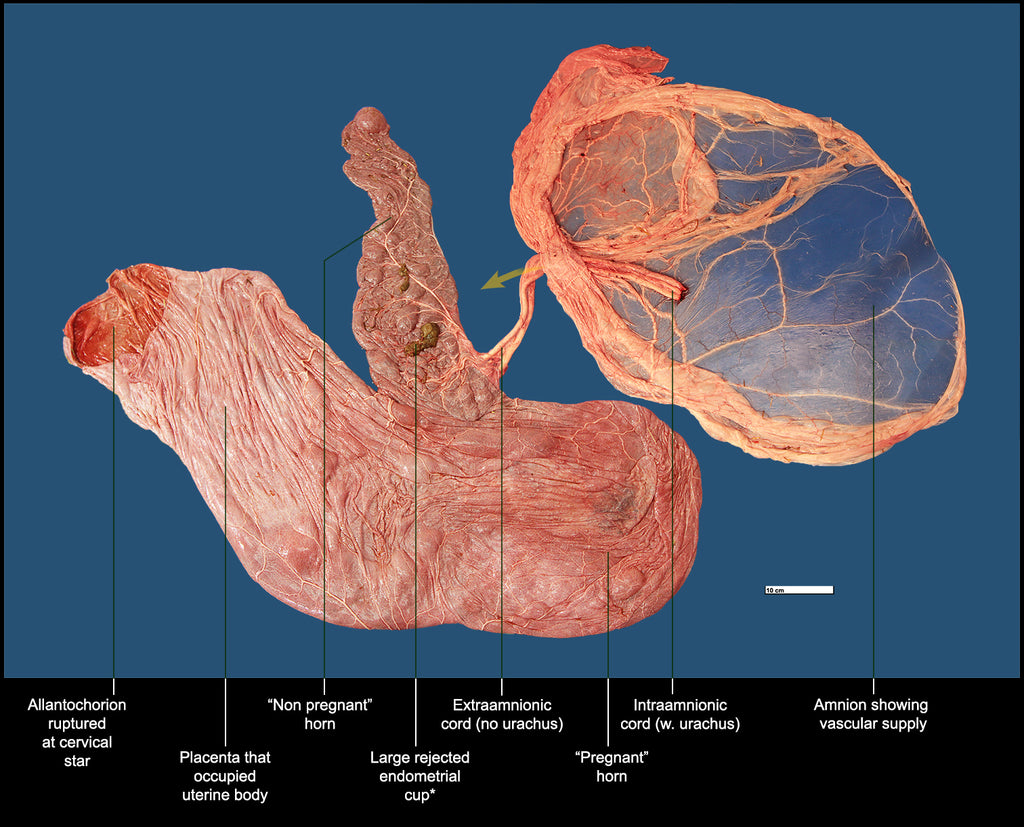Image from https://loriequinesection.blogspot.com/2019/05/fetal-placental-circulation-and.html
After foaling and the passing of your mares placenta, the placenta should be checked for completeness and tears. If any placenta remains in the uterus, infection may occur or worse.
- Lay out in an F shape.
- Examine the placenta from both sides. It will present in-side out. Examine that side and then turn in the right way.
- The uterus has two horns. The pregnant horn will be longer, thicker and have slightly more fluid. The non-pregnant horn will be shorter and thinner with more folds because it has not been stretched.
- If a piece is retained it is usually the tip of the non-pregnant horn - but not in all cases.
- There should be a tear where the foals feet ruptured the placenta at the cervix. This is called the cervical star and is located at the body of the placenta. • The umbilical cord should be attached. Note twists, haemorrhage, dilation or bruising in case the foal develops a problem.
- Check for yellowish/brown meconium staining that indicates foetal stress.
- Note colour, tears, weight, thickness, haemorrhage or any abnormalities.
If ever concerned keep the placenta for the vet to assess and call your vet immediately. A handy diagram of a healthy placenta and information thanks to the Orange Vet Hospital NSW. https://orangevet.com.au/wp-content/uploads/2019/05/OVH-pregnant-mare-care.pdf

As well as looking for tears and missing pieces, it's important to make sure the placenta looks healthy. As discussed in another post on placentitis, some mares don't show any signs before giving birth.
Below is a photo from a Smart Foal customer who discovered the mare had placentitis after the foal was born. The foal was premature and had quite weak legs that deteriorated over time.
"Pretty sure the smart foal alarm saved both of these girls last night! Mare wasn’t due for another 4 weeks and went from nothing to waxed up pretty much overnight so popped the alarm on her she wasn’t uncomfortable or showing signs of labour. Hardware alarm went off during the night went and checked her she has foaled a tiny filly but she was still alive and quite feisty, she wasn’t overly interested in the foal and was incredibly distressed she passed the placenta which wasn’t normal at all so called the vet at 2am looks like she had placentitis and showed no symptoms and has gone to abort the foal but luckily she appears to be viable! Polly was given pain relief and buscapan as she was mildly colicky post foaling, the filly although unable to stand was constantly trying so we left them to bond for a little bit when checked on later if foal was lifted she could now stand on her own although not drinking yet, another two hours later and she was able to get herself up and unsteadily find mum, although not the boobs! Finally approx 8-9hours post birth we witnessed her get on the teat herself! Although we did tube a small amount into her as we milked mum post foaling and she hadn’t had much to drink in her three sucks! Getting close to 24 hours post foaling now and mum no longer in pain is super attentive and filly is able to find the milk bar every time she gets to her feet fingers crossed she continues to be stronger!! If I hadn’t had the alarm on I feel it would have been a very different outcome!!" B Hendrix 2019.

As well treating the mare for the infection, it's a good idea to take some immediate action with the foal. Call a vet and have the foal assessed. As with other premature foals, there can be problems with bone development, muscle weakness, organ function and the list goes on. Early and aggressive intervention can improve the long term prognosis for the foal and prevent life long bone problems. It is also worth noting that most premature foals suffer from some amount of failure of passive transfer. Foals are born without an immune system so giving the foal additional antibodies (either plasma or colostrum) along with antibiotics is a good idea*.
Information from: *McKinnon, Angus O., et al. Equine Reproduction. 2nd ed., Wiley-Blackwell, 2011.

